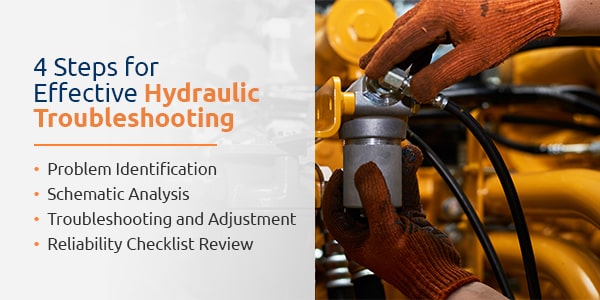Hydraulic Troubleshooting 101

Hydraulics systems require careful maintenance to be operational, safe and efficient. Learning how to troubleshoot common problems is key to maintaining your system and keeping it healthy over a long period. Proper care can prevent downtime and help your engineers, mechanics and managers boost your organization’s bottom line.

4 Steps for Effective Hydraulic Troubleshooting
For decades, experts have been perfecting four hydraulics troubleshooting steps you can follow to find solutions.
1. Problem Identification
Begin by addressing whether your hydraulic problem comes from pressure or volume.
A pressure problem happens when the machine can’t perform properly because the pressure won’t build high enough. For example, a press that requires 4,000 pounds per square inch (psi) may only generate 3,000 psi. If the issue relates to how fast the boiler performs, it’s likely a volume issue.
Perform a visual inspection and confirm you’ve identified the correct problem. You’ll need to check the oil level, oil analysis report, filter condition, pump coupling conditions, leakage and more. It’s vital to interview machine operators since they have a baseline for how the machine should run.
2. Schematic Analysis
Although visual checks are an effective tool, analyzing a schematic is crucial. Engineers often design valves or manifolds in difficult-to-find locations. Checking these problem spots first may result in hours of saved time on visual diagnosis. For example, a blown fuse on a solenoid-operated valve is easy to fix but can cause countless hours of downtime if out of sight.
3. Troubleshooting and Adjustment
Hydraulics troubleshooting isolates one portion of the system at a time so that you can rule out potential problems.
First, ensure that the system pressures are at the proper settings. You will need to check the pump compensator as well as the pressure reducing, control and relief valves. It’s often a simple fix to adjust the pressure on a valve.
Next, confirm that there is no excessive bypassing of temperature levels anywhere in the system. You can use an infrared camera or temperature gun to complete this process. It’s also vital to check the volume accumulators with a temperature gun to ensure they are cycling properly.
4. Reliability Checklist Review
Once you’ve repaired the issue, create a system reliability checklist. Reviewing these issues can help you prevent unscheduled downtime and catch issues before they occur. For example, high fluid temperatures over time can be a sign of an underlying problem.
Your checklist should include:
- Pressure readings
- Temperature readings
- Electric motor readings
- Voltages to proportional valves
- Filter and breather conditions
- Hose and clamp conditions
- Oil cleanliness
Learn More and Explore Hydraulic Repair Options
Hydraulic machinery is a key contributor to a successful production supply chain. At Global Electronic Services, we’re committed to helping you decrease downtime with rapid and high-quality repairs.
If your hydraulic equipment needs troubleshooting or repair, reach out to us online or give us a call at 877-249-1701. We’ll provide you with a competitively priced quote for hydraulic and pneumatic repair services with turnarounds as fast as a few days.